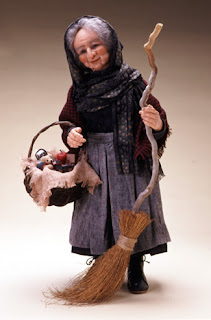At each house where she stops she leaves small presents in the stockings that have been left out by the children of the family. If she finds that the child has been bad there may be a lump of coal or an onion but more often she rewards children for the times they were good with sweets, oranges, toys and games. And because she comes down the chimney and is a good housekeeper she sweeps away the soot so no trace of her entry can be found. Then, if thoughtful children have left one behind, she may partake of a glass of local wine or even a biscotti to warm her old bones and give her strength to continue her journey on to the next house. It is also known that if she is spied upon she will take her broom stick to the offenders and never visit them again.
Over the past few years I have written about the various versions of the story of La Befana and it seems each year I find another one including this rather lovely variation on her tale at My Merry Christmas. It is a tradition I have grown to love and cherish as part of my Christmas and once again this year she graced the tree and has been keeping an eye on things from the hutch until the 12th day of Christmastide comes to an end and things are put away until next year.
Though her tale is now steeped in Christian mythology it is likely that her origins - as with much in Christianity - are pagan. She may be related to Strenua the Sabine goddess of strength and endurance whose feast came at the beginning of the New Year and included the exchange of gifts. This festivity was considered riotous and licentious by early Christians but as Thomas Macaulay remarked "Christianity conquered paganism, but paganism infected Christianity." In some northern Italian cultures she represents the Old Year and a puppet of an old lady is burned on a larger bonfire in a public square (Fellini captured that rite in his Amacord) - a pagan tradition that can be found in many Celtic cultures.
Though she is celebrated throughout Italy - and in many Italian communities worldwide - the town of Urbania in Pesaro is closely associated with La Befana. From January 2 until the 6th the town celebrates La Festa Nationale della Befana with food, fairs, rides, games, parades and more Befane that you can shake a broom at.
These are a few sketches of the street decorations designed by Loris Grisi for this year's festa - stockings, sacks of goodies, brooms, the only thing missing is the old lady herself. But as this little sideshow proves there is no lack of guests-of-honour at this celebration.

Viene, viene la BefanaAnd hopefully on her journey tonight she has brought happiness and good things to all my dear friends in Italy. Viva la Befana Viva!
Vien dai monti a notte fonda
Come è stanca! la circonda
Neve e gelo e tramontana!
Viene, viene la Befana
Here comes, here comes the Befana
She comes from the mountains in the deep of the night
Look how tired she is! All wrapped up
In snow and frost and the north wind!
Here comes, here comes the Befana!
Giovanni Pascoli
05 January - 1759 - George Washington married Martha Dandridge Custis



4 comments:
I like the version that she is looking for the Christ child because of the underlying message that the holy child could be every child.
Oh! la Befana and la tramontana...telling me, it has been blowing high since last night and I am not surprised now, it is always reassuring to know the cause of minor disastrous, like tiles flying and breaking with thundering noise ! But I did not get a little present... (though this nice post and the sweet sketchings are like presents!)We have already shared two 'King cakes' (gâteau des Rois...)
if she had come to where I lived 40+ years ago she could have had mine.
Is there a doll like this for sale somewhere? I love it as well as your story !
Post a Comment